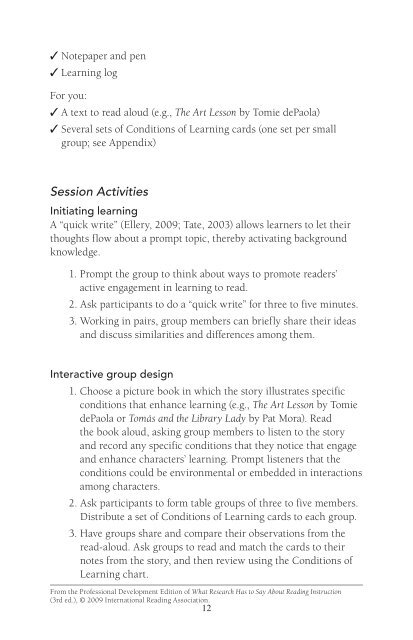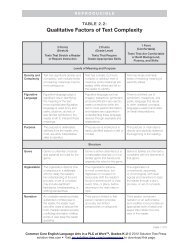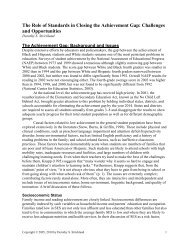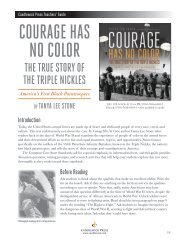What Research Has to Say About Reading Instruction - International ...
What Research Has to Say About Reading Instruction - International ...
What Research Has to Say About Reading Instruction - International ...
You also want an ePaper? Increase the reach of your titles
YUMPU automatically turns print PDFs into web optimized ePapers that Google loves.
✓ Notepaper and pen<br />
✓ Learning log<br />
For you:<br />
✓ A text <strong>to</strong> read aloud (e.g., The Art Lesson by Tomie dePaola)<br />
✓ Several sets of Conditions of Learning cards (one set per small<br />
group; see Appendix)<br />
Session Activities<br />
Initiating learning<br />
A “quick write” (Ellery, 2009; Tate, 2003) allows learners <strong>to</strong> let their<br />
thoughts flow about a prompt <strong>to</strong>pic, thereby activating background<br />
knowledge.<br />
1. Prompt the group <strong>to</strong> think about ways <strong>to</strong> promote readers’<br />
active engagement in learning <strong>to</strong> read.<br />
2. Ask participants <strong>to</strong> do a “quick write” for three <strong>to</strong> five minutes.<br />
3. Working in pairs, group members can briefly share their ideas<br />
and discuss similarities and differences among them.<br />
Interactive group design<br />
1. Choose a picture book in which the s<strong>to</strong>ry illustrates specific<br />
conditions that enhance learning (e.g., The Art Lesson by Tomie<br />
dePaola or Tomás and the Library Lady by Pat Mora). Read<br />
the book aloud, asking group members <strong>to</strong> listen <strong>to</strong> the s<strong>to</strong>ry<br />
and record any specific conditions that they notice that engage<br />
and enhance characters’ learning. Prompt listeners that the<br />
conditions could be environmental or embedded in interactions<br />
among characters.<br />
2. Ask participants <strong>to</strong> form table groups of three <strong>to</strong> five members.<br />
Distribute a set of Conditions of Learning cards <strong>to</strong> each group.<br />
3. Have groups share and compare their observations from the<br />
read-aloud. Ask groups <strong>to</strong> read and match the cards <strong>to</strong> their<br />
notes from the s<strong>to</strong>ry, and then review using the Conditions of<br />
Learning chart.<br />
From the Professional Development Edition of <strong>What</strong> <strong>Research</strong> <strong>Has</strong> <strong>to</strong> <strong>Say</strong> <strong>About</strong> <strong>Reading</strong> <strong>Instruction</strong><br />
(3rd ed.), © 2009 <strong>International</strong> <strong>Reading</strong> Association.<br />
12
















